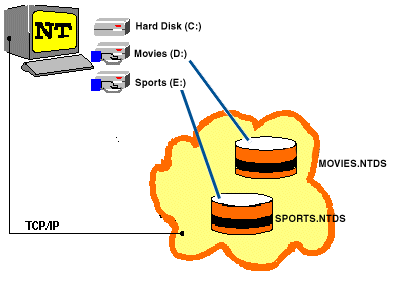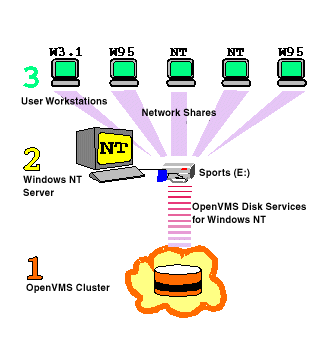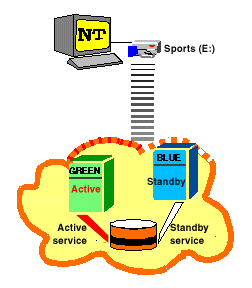This chapter contains the following sections:
DIGITAL OpenVMS Disk Services for Windows NT lets you use your OpenVMS Cluster to store Windows NT data. The OpenVMS Alpha nodes in your cluster serve virtual disks to Windows NT computers.
On the Windows NT computer, you format the virtual disk with a native file system, such as NTFS. It behaves just like a locally attached disk, although its data is actually stored in a container file on your OpenVMS Cluster.
The following picture shows a Windows NT computer whose D: and E: drives are virtual disks whose data is stored in the OpenVMS container files MOVIES.NTDS and SPORTS.NTDS respectively.

DIGITAL OpenVMS Disk Services for Windows NT gives you centralized storage. You can store Windows NT data on your OpenVMS Cluster, and you can use your existing OpenVMS backup schedules to back up both your Windows NT and OpenVMS data.
DIGITAL OpenVMS Disk Services for Windows NT also provides a flexible way of allocating storage. You can use it to divide large OpenVMS disks into smaller virtual disks and connect each virtual disk to a different Windows NT computer.
For example, your OpenVMS Cluster has a 60 GB RAID array that you want to use to provide storage for three Windows NT application servers. You create three virtual disks: a 30 GB disk for your Microsoft Exchange mail server, and two 15 GB disks, one for your Lotus Notes server and one for your web server.
A fire destroys your Lotus Notes server. Its virtual disk is safe because it is being served by an OpenVMS Cluster that is distributed across various sites and survives the fire. To get the notes service up and running again, you simply use DIGITAL OpenVMS Disk Services for Windows NT's point- and-click interface to connect another Lotus Notes server to the virtual disk.
Note that DIGITAL OpenVMS Disk Services for Windows NT does not run on OpenVMS VAX. In a mixed architecture OpenVMS Cluster, only the OpenVMS Alpha nodes can provide disk services.
PATHWORKS and DIGITAL OpenVMS Disk Services for Windows NT provide Windows NT computers with very different types of services:
The file services let you share data between OpenVMS and Windows NT applications. Both OpenVMS and Windows NT applications can access the same files.
It serves raw disk blocks, not files, to the Windows NT computer that is connected to the service. OpenVMS applications cannot access the data stored on the virtual disk, just as they cannot access the data stored on a real disk that is locally attached to the Windows NT computer.
At any one time, only one Windows NT computer can connect to a particular disk service. That computer can share the virtual disk out to other computers, in the same way that it can share its real disks out to other computers.
This makes DIGITAL OpenVMS Disk Services for Windows NT the ideal fit for the 3-tier client- server environment shown in this picture:

The OpenVMS Cluster at tier 1 serves disk storage to Windows NT servers at tier 2, which share it out to user workstations at tier 3.
The Windows NT computer at tier 2 uses TCP/IP to communicate with the OpenVMS Cluster at tier 1.
The following picture shows a single disk service. A container file on an OpenVMS disk stores the disk blocks for the virtual disk on the Windows NT computer.

The Windows NT computer is designed around the assumption that the probability of not being able to access any disk is low. This applies to virtual disks as well as to real ones. To fulfill the assumption, you must make sure that the disk service at the OpenVMS Cluster end is always available. You do this by setting up one or more standbys for each disk service that your OpenVMS Cluster provides, as described in Section 2.2.
In the previous picture, the active disk service is on GREEN, and there is a standby disk service on BLUE.
If GREEN fails, the service automatically fails over to BLUE. The failover is transparent to the Windows NT computer; users carry on using the service, unaware that it is now being provided by node BLUE.
For example, if you have two FDDI connections between the Windows NT computer and the cluster, if one of the FDDI links fails the other one automatically takes over, transparently to users.
Only one Windows NT computer can connect to a particular disk service at any one time.
If the computer currently connected to the service fails, you can connect a different Windows NT computer to the service, as described in Section 3.4.
When the original Windows NT computer restarts, it automatically tries to reconnect to the service. If the service happens to fail over from one node in the OpenVMS Cluster to another while it is restarting, it might succeed in reconnecting to the service, stealing the connection back from the other Windows NT computer. If this happens, your data could be corrupted.
To avoid data corruption, never connect another Windows NT computer to a disk service if there is any possibility that the original Windows NT computer could reconnect to it.
For example, it is safe to connect another computer to the service if the original computer was destroyed in a fire, or if you have removed its network cards so that when it restarts it will not be able to communicate with the OpenVMS Cluster that is providing the service.
The following table shows the hardware and software you need to install Version 1.0 of DIGITAL OpenVMS Disk Services for Windows NT.
| OpenVMS Alpha | Windows NT |
|---|---|
An Alpha system that:
| A Windows NT server or workstation (Intel or Alpha
CPU) that:
|
|
+ This TIMA kit is included in the kit for Version 1.0 of DIGITAL OpenVMS Disk Services for Windows NT, and is placed in SYS$UPDATE when you install DIGITAL OpenVMS Disk Services for Windows NT. | |
Yes, you need a license to use DIGITAL OpenVMS Disk Services for Windows NT. Your license controls how many different Windows NT computers can connect to the disk services on your OpenVMS Cluster at any one time.
Purchase the NTDS-DISK Product Authorization Key (PAK) and register it in your OpenVMS license database, as described in Installing DIGITAL OpenVMS Disk Services for Windows NT.
You can use a virtual disk created by DIGITAL OpenVMS Disk Services for Windows NT just like a real disk that is locally attached to the Windows NT computer, with the following restrictions:
If you want striping or mirroring, create the container file on an OpenVMS disk that is striped or shadowed.
A Windows NT computer can connect to a disk service on your OpenVMS Cluster provided that:
Copyright © Digital Equipment Corporation 1997. All Rights Reserved.